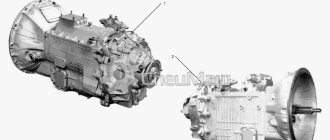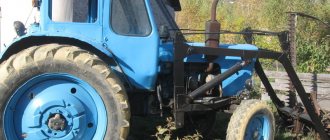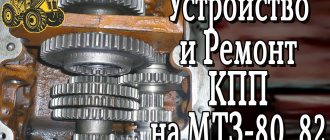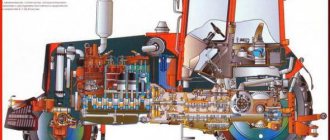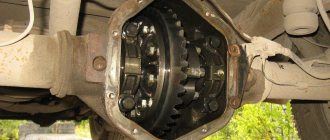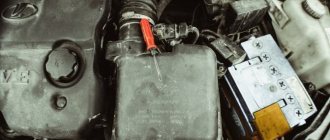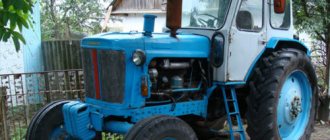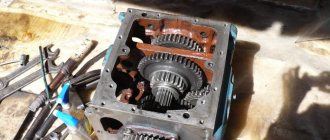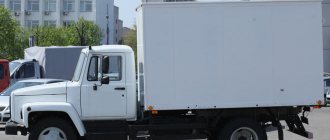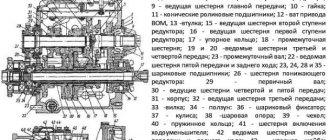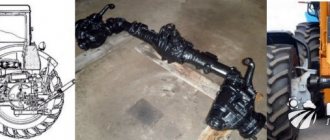The GAZ-53 truck is the legendary Soviet “toiler”. The car was produced serially from 1961 to 1993. However, despite the cessation of production in the early 90s, this car is still found in the fleets of most enterprises. Private owners also have this car. Thanks to the fact that the truck was assembled with high quality, and the same high-quality and durable spare parts were used for assembly, the GAZ-53 was able to survive to this day. The only thing that sometimes raises questions about the 53rd LAWN is the gearbox. Let's look at how this unit works, typical faults and repair methods.
Gearbox repair
In fact, it is not difficult to repair the box, but a professional will do it faster. Self-repair is also possible if spare parts are available. GAZ-53 is a very repairable car. Finding spare parts for it is now not a problem, and you can buy them in the markets at an affordable price.
Often, repairing a unit can be expensive. In this case, you can save money by replacing the box with a used one. The modern automotive market offers a lot of options. It is only recommended to agree in advance on the possibility of return in case of malfunction.
The plant produced many transmissions for these cars. Therefore, finding a used unit will not be difficult. Prices for units are affordable. You can also install a transmission from a GAZ-63 truck. It is completely identical and interchangeable.
Engine
GAZ 53 was equipped with a variety of engines. The first modifications were equipped with 6-cylinder GAZ 11 units. They were distinguished by significant fuel consumption (up to 25 l/100 km) and simplicity of design. The engine power (82 hp) was not enough for the truck.
The GAZ 11 engine was replaced by the ZMZ 53 unit. Most versions of the GAZ 53 were equipped with it. The engine had a cast cylinder block and a classic V-shaped monoblock design. Cast iron sleeves and block cavities formed the water cooling jacket of the unit. The piston group was cast from aluminum alloy, the block head from Al-4 alloy. The crankshaft was made of cast iron. It was mandatory to undergo static and dynamic balancing. The engine received a K-126 carburetor and a contact ignition system. The engine used a closed liquid cooling system with a water pump.
Characteristics of the ZMZ 53 motor:
- working volume – 4.25 l;
- rated power - 115 hp;
- maximum torque – 284.5 Nm;
- number of cylinders – 8;
- compression ratio – 7.6.
The third modification of the GAZ 53 was equipped with a modernized ZMZ 53-11 unit, which differed from its predecessor in a sectional oil pump, a closed crankcase ventilation circuit and a full-flow filter element.
Characteristics of the ZMZ 53-11 motor:
- working volume – 4.25 l;
- rated power – 120 hp.
This is interesting: Do I need to turn on the neutral on the robot box?
Synchronizer device and operating principle
As noted above, the first samples were equipped with a basic GAZ-53 gearbox. Its device includes synchronizers. Let's look at how they work and how they are designed.
Using a synchronizer, third and fourth gears are engaged. This mechanism is a hub, which is mounted on the secondary shaft of the gearbox. On its outer surface there are splines along which the coupling moves. The latter is controlled by a fork. In the grooves of the hub there are blocking “crackers” and locking springs. There are bronze blocking rings on the sides. The rings have an internal cone and a gear ring on the outside. Special conical surfaces are made on the third gear gear and on the input shaft gear. When switching, the locking rings come into contact with these surfaces, and then friction occurs between them. Due to this, the rotation speeds of the shafts and gears are equalized. Gears shift more smoothly.
Technical specifications
We looked at how the GAZ-53 gearbox works. Her characteristics were quite good. Let's consider the transmission capabilities.
The unit is equipped with a three-way lever, and the transmission has forward speeds and one reverse gear. The weight of the unit is 56 kilograms. The oil in the GAZ-53 gearbox is poured into a special 3-liter container.
Let's look at the gear ratios of this transmission. For first gear – 6.55. For the second – 3.09. Third gear has a gear ratio of 1.71. The fourth speed is direct, and the gear ratio is 1. The reverse speed has a parameter of 7.77.
Where is the drive shaft of the box located?
On a GAZ-53 car, the drive shaft of the box is installed with the front part at the end of the crankshaft. The rear end is attached to the box housing, which is made of cast iron.
A roller bearing is installed at the end of the drive shaft, onto which the front end of the driven shaft is mounted, while the rear part rests on a ball bearing. The driven shaft contains gears for 1st, 2nd and 3rd gears, as well as a synchronizer, which serves to silently and smoothly connect pairs of gears.
Gearbox of a GAZ 53 car
The body in which all the elements of the GAZ 53 gearbox are placed is made of cast iron.
Gears are difficult to engage
Often, if the gears are poorly engaged, it is not the gearbox mechanism that is to blame, but the clutch. The first step is to diagnose the clutch parts, and also make sure that the pedal is depressed normally.
If third and fourth gears do not engage, the cause is often a malfunction of the synchronizers or clutch in these gears. The speeds will be difficult to engage if there is no oil.
Failure or wear of the gear selector mechanism will prevent the transmission from operating normally. Often the cause is wear of the rods. It's also worth checking the springs. Repair involves disassembling and replacing worn or damaged spare parts - GAZ-53 spare parts, despite its age, can still be purchased.
About the areas of application and modifications of the GAZ-53
On its not particularly powerful shoulders, the GAZ-53 nevertheless “rolled” at least half of the entire economy of the Country of Soviets. It's hard to find where this ubiquitous truck has NOT been used. From the “gait” for emergency crews and the “paddy wagon” for criminals to mobile fuel tankers and truck tractors that hauled containers - everything that was not installed on the GAZ-53 chassis!
These cheap, simple and unpretentious trucks have become widespread in agriculture. In the 70s/early 80s of the 20th century, on the average Soviet collective farm, 80% of the truck fleet consisted of GAZ-53. Only in the second half of the 80s did this ratio begin to change towards an increase in the share of ZIL-130, which, by the way, in Soviet times did not cost much more than GAZon.
GAZ-53 of the 60s and 80s both look noticeably different from each other, and in a technological sense these are two quite different trucks. Not only are their engines completely different, but also many other design elements.
After all, over the years of production, the GAZ-53 has experienced three major and many minor upgrades and improvements. The Gorky Automobile Plant tried to promptly respond to “signals from the field” and eliminate problems identified during operation.
Thus, already in the first years of the distribution of the new truck model across the country, it became obvious that the axles from the previous generation - GAZ-51, were no longer suitable for the 53rd, and the 82-horsepower engine from the 51st GAZon, although forced, did not respond the increased needs of the new machine. During 1964/65, serial production of the GAZ-53 was launched, equipped, instead of an in-line six-cylinder engine, with a V-shaped eight (115-horsepower ZMZ-53 engine), as well as modified and reinforced axles.
An interesting, half-forgotten fact: the cladding and, accordingly, the appearance of the GAZ-53 of the first releases were very noticeably different from the appearance of the car we are accustomed to. For example, the headlights were located above the direction indicators. However, unfortunately, not a single original LAWN of that very first generation has survived to this day. But he remained captured on film in some famous films of that time, in particular “Happy Troubles” (1964), “Foreigner” (1965), “Beware of the Car” (1966), “Three Poplars on Plyushchikha” (1967).
GAZ-53F (1961—1967)
By the way, a curious film curiosity is associated with the GAZ-53, which has already become familiar to everyone. In the famous film “The Meeting Place Cannot Be Changed,” in the episode when gang members are driving Volodya Sharapov in a GAZ-AA bread van through Moscow at night, a green GAZ-53 was inappropriately included in some shots. (The film takes place in 1946).
"GAZ-53A" (1965–1983)
Three main, basic modifications of the truck rolled off the assembly line under the following factory indices:
- GAZ-53F (1961-1967) - flatbed truck and universal chassis with a forced in-line 6-cylinder GAZ-51 engine with a power of 82 hp.
- GAZ-53A (from June 1965 to 1983) - flatbed truck, dump truck and universal chassis with a ZMZ-53 engine - V-shaped 8-cylinder, 115 hp.
- GAZ-53-12 (from 1983 to January 1993) - flatbed truck, dump truck and universal chassis with an eight-cylinder V-shaped engine ZMZ-53-11 with a power of 120 hp.
According to the power, the load capacity of the three generations of the 53rd LAWN also differs. The GAZ-53F was declared to have a 4-ton capacity, although in fact it only carried 3 tons on board, and 4 tons was an almost unbearable load for it. The GAZ-53A became a real four-ton truck. The power of the GAZ-53-12 engine already allowed it to freely carry not only the 4.5 tons declared by the manufacturer, but also 5 tons “with kopecks”.
GAZ-53-12 (1983-1993)
In addition to the basic ones, there are dozens of modifications and versions of the GAZ-53 made on their basis, intended for use for specialized purposes. Among them -
- Military modification of the GAZ-53N with an additional 105 liter fuel tank, a pre-heater and a set of additional equipment.
- The widely used KAVZ-685 and Kuban based on the GAZ-53. They were produced on the GAZ-53-40 chassis, equipped with softer springs and telescopic shock absorbers, a fuel tank from the GAZ-66, a modified brake system and electrical equipment.
- GAZ-53-02 – dump truck.
- A special chassis designed for the GAZ-SAZ dump truck (SAZ-3503).
- GAZ-53-05 is a truck tractor (it was not widely used, because any of the three engines of the 53rd GAZon was too weak for such “exercises”).
- GAZ-53-19 and GAZ-53-27 - versions developed in 1984, running on liquefied gas; with engines of 105 and 100 hp. respectively.
GAZ-53 trucks were exported to almost all socialist countries, and from capitalist countries to Finland and Belgium.
Serious assembly production of these trucks, from Soviet vehicle kits, was organized in Bulgaria and Cuba. Moreover, the Bulgarian enterprise Madara produced the GAZ-53 from 1967 to 1991, increasing production volume to 3,000 cars per year in the 80s. And already from the beginning of the 70s, it equipped them with Bulgarian-made engines.
Export versions of the truck were produced with the factory designations GAZ-53-70 and GAZ-53-50 (especially for the tropics). As already noted, the number of specialized versions based on the GAZ-53 chassis is difficult to calculate. These include mobile repair shops, fire trucks, truck cranes, ladder trucks, garbage trucks, loader cranes, fuel tankers, etc. and so on.
This is interesting: How much does a VAZ 2101 engine block weigh?
Front axle
The front axle on the GAZ 53 truck is a massive beam, which is the supporting basis for the entire front suspension. The beam has an I-section, its ends have eyes for installing rotary axles using a pin connection. The axles (steering knuckles), in turn, are connected to steering rods, through which the wheels turn. Bronze or brass bushings are pressed into the seats (eyes) under the pivots. The steering knuckles are mounted on the front wheel hub bearings; the bearings are filled with thick grease of the “litol” type.
Front axle malfunctions
Only one problem can happen to the beam itself - the seats for the pin bushings will be worn out. It is not easy to bend or break such a massive element. But first of all, the pins and the bushings themselves wear out.
Front axle drawing for GAZ 53
A sign of a front axle malfunction may be a knocking sound in the area of the front wheels. The knocking occurs due to increased play in the pivot joints.
It is not difficult to determine the defect - you need to hang one front wheel on a jack and rock it up and down. It is believed that if the play is more than 1.6 mm, the kingpins and bushings must be replaced. But how these millimeters are measured is not very clear. It’s just that if there is a noticeable gap, it’s time to repair the front axle. The wheel bearings on the front axle may be noisy. The defect of the front bearing is checked in the same way as on the rear axle - the wheel is hung up and rotated.
Checking the bearing of the front axle GAZ 53
Replacing king pins
It is more convenient to change the pivots in a pit in the garage, but the work can also be done in the field. The main thing is that the car is installed on a flat surface. To disassemble, you must perform the following operations:
- Loosen the nuts on the front wheels;
- Raise the front of the car by removing the wheels and placing reliable supports under the frame;
- Remove the front wheel hubs complete with brake drums and bearings;
- Disconnect the brake support discs and hang them on the tubes, moving them to the side;
- Disconnect the steering rods from the steering axles;
- Unscrew the bolts securing the king pin covers (upper and lower) and remove the covers;
- Release all fasteners and knock out the locking wedges holding the king pins (one wedge per side);
- Using a mandrel, knock the pins down;
- Remove the pivot pins, rubber seals and king pin thrust bearings.
The removed steering knuckles must be clamped in a vice and the bushings must be knocked out of their seats using a mandrel. New bushings are pressed in, and using a reamer with a diameter of 30 mm, both seats for the kingpins are deployed simultaneously. Therefore, the scan must be long. It is important not to miss the size - the kingpin must fit into the bushings very tightly. It is necessary to take into account that the soft metal will quickly settle, and if it fits freely at the assembly stage, backlash may appear almost immediately in the future. When installing bushings, you should check the alignment of the holes for lubrication of the king pin. Everything is put together in reverse order.
Often the pins in the seats boil, especially in cases where the bridge was forgotten to be serviced and was not sprayed.
In such cases, the connection is heated with a gas torch, and you will definitely have to stock up on a good sledgehammer. It is important to move the king pin out of place, and then it should come out easier.
To replace the kingpins, a special kit is sold in car dealerships. The standard set includes:
- Pivots – 2 pcs.;
- Bronze bushings – 4 pcs.;
- Plugs – 4 pcs.;
- Locking pins (wedges) – 2 pcs.;
- Thrust bearings – 2 pcs.;
- O-rings – 4 pcs.;
- Fasteners (bolts, washers, nuts);
- Protective cap 3307-3001017 (boot) – 2 pcs.;
- Grease nipple for injection - 4 pcs.
A factory set costs around 900 to 120 rubles.
Front Axle Maintenance
Front axle maintenance consists of:
- In the lubrication of pivot joints and wheel bearings;
- Checking the play in the hub bearings;
- Diagnostics of steering rods, hubs, king pins.
It is recommended to spray the front axle of a GAZ 53 approximately once every 10 thousand km.
This is what the front axle from a GAZ 53 truck looks like
Principle of operation
The GAZ-53 gearbox operates according to the following scheme. The front part of the input shaft is fixed in the crankshaft bearing. The primary shaft is connected to the secondary shaft at the rear via a needle bearing.
The torque is transmitted through the intermediate shaft. Each gear has a different ratio. Thanks to this, speed and thrust change. Direct transmission on the GAZ-53 gearbox is fourth, as on most cars.
Extraneous sounds when the unit is operating
The transmission may make different sounds depending on what mode it is in. If an extraneous sound is heard only when the clutch is fully depressed, then the reason is the bearing. It is located on the transmission input shaft. If you put the car in gear and drive, the grinding noise indicates broken or worn teeth on the gears.
Extraneous sounds when fourth gear is engaged indicate wear on the input shaft, as well as the bearings on this shaft and on the secondary one. If there is no oil in the unit, the transmission will make noise regardless of the operating modes.
Disassembling the GAZ-53 gearbox with subsequent troubleshooting and replacement of parts will help to identify the exact cause of the sounds. However, sometimes it is difficult to determine the breakdown upon inspection. Maximum attention is paid to the element located next to the noisy transmission. The box often howls. This is especially pronounced when driving at low speeds. For the 53rd LAWN, this sound is quite normal.
About the causes of malfunctions
Often the main cause of all breakdowns in this box is from an insufficient amount of gear oil or its absence at all in the gearbox mechanism. Also, the incorrect use of the mechanism is often the cause of the malfunction. Often, breakdowns are associated with natural wear of gears. Less often - with a manufacturing defect (since in the USSR they were made “for centuries”). If the truck is operated in extreme conditions for a long time, this also leads to failure of the unit.
Signs of transmission failure
On a GAZ-53, the gearbox rarely fails. Malfunctions can be identified by certain signs. Breakdowns are accompanied by noise and extraneous sounds when the unit is operating.
Malfunctions will be indicated by noise near the place where the unit is installed. Sometimes the transmission cannot be switched on. And if it turns out that serious effort is required, this is also a sign of breakdown. If any gear does not work and does not engage, the speed drops, it is worth inspecting the transmission in more detail. Also, noise during movement indicates a breakdown. Often on the GAZ-53 the gearbox did not allow the lever to be moved to neutral. Because of this, it was impossible to turn off the transmission.
How does the checkpoint work?
When the lever is moved to the left from neutral, its lower part moves the shift fork and rod, which forces the first gear gear to move backward and engages it with the gear responsible for first gear. The latter is installed on the intermediate shaft. When the clutch is engaged, the torque is transported through the gears, which are constantly in mesh, towards the intermediate shaft to the secondary shaft.
To engage the third speed, the selector is moved from neutral to the right, and then forward. Under the influence of the fork, the synchronizer clutch will begin to move backward, after which this mechanism will begin to act on the synchronizer. In this case, the torque comes from the gearbox input shaft through gears that are constantly engaged. The moment is transported through the intermediate shaft to the secondary shaft of the box.
To engage fourth speed, the selector must be moved from neutral to the right. Then the lever is moved back. The clutch will move forward and the synchronizer ring will engage the input shaft. Then, after balancing the speeds, the gear will engage.
To engage reverse gear, it is necessary to overcome the force of the safety system. The lever must be moved to the right.
